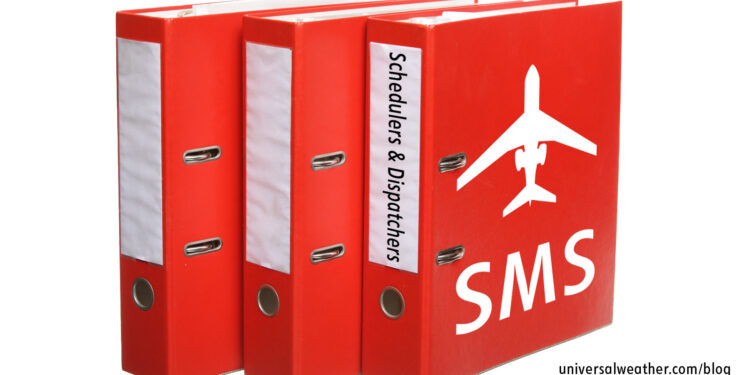SMS/IS-BAO Considerations for Schedulers and Dispatchers – Part 1: Understanding SMS

Safety Management System (SMS) regulations have been implemented in various States around the world, and the expectation is that in the next five years, many more States will follow suit. Initially, these regulations will impact those States’ registered scheduled and non-scheduled (charter) commercial operations. However, it is also expected that these States will implement regulations for private (non-commercial) operators. While it’s important to understand SMS regulatory requirements, operators must also maintain awareness of the ‘big picture’ and enhanced safety of operations when developing an effective SMS program.
1. What are regulations regarding SMS?
SMS requirements for aircraft operators originate from the International Civil Aviation Organization (ICAO) Annex 6 Part I – International Commercial Air Transport, and Part II, Section 3 – International General Aviation, Large and Turbojet Airplanes (takeoff mass greater than 5700 kg or aircraft equipped with one or more turbojet engines).
For Annex 6 Part I operators, responsibility has been put on the State’s Civil Aviation Authority to: 1) Establish a State safety program, and: 2) as part of the State safety program, require that an operator implement a safety management system. In other words, the State is responsible for drafting and implementing requirements (regulations) for SMS. Annex 6 Part II, on the other hand, places the responsibility for SMS directly on the operator. Accordingly, the standard says, “An operator shall establish and maintain a safety management system that is appropriate to the size and complexity of the operation.”
In other words, for international commercial operations, the State is responsible for implementing the SMS requirement into the regulatory framework. For large aircraft and/or turbojet-powered general aviation, the operator is responsible for implementing SMS without a requirement from the State. It is also at the discretion of the State Civil Aviation Authority to enforce this requirement, not only on State -registered general aviation, but also on visiting aircraft operators that fall under the Annex 6 Part II, Section 3 requirements.
2. Do SMS regulations apply to private operations?
Some ICAO states are beginning to draft and implement SMS regulations for Annex Part II operators. As stated, this pertains to operators of aircraft over 5700 kg (12,500 lbs.) or turbojet-equipped. Bermuda overtly enforces this requirement on transient private aircraft. If you’re ramp-checked in Bermuda and do not have an approved SMS program in place, or one is being implemented, you’ll receive a warning. You may be barred from future operations to Bermuda until you’ve demonstrated compliance with the Annex 6, Part II SMS requirement.
3. What are current, acceptable means of compliance with the SMS requirements for private non-revenue aircraft visiting Bermuda?
Compliance with the Annex 6, Part II SMS requirement is monitored by random ramp inspections in Bermuda (TXKF). In relation to proof of compliance with the SMS requirements, the Bermuda Dept. of Civil Aviation (DCA) accepts the following as evidence:
- IS-BAO registration
- Air Charter Safety Foundation (ACSF) registration
- ARG/US Platinum rating
- Wyvern registration
- An SMS manual deemed acceptable by the State of Registry
- Proof of intent to produce an SMS (e.g. a contract with a service provider who is enabling IS-BAO registration or a letter from ICAC confirming the purchase of the IS-BAO standard. If a service provider has been approved by Bermuda DCA, an announcement can be found on the Bermuda DCA website—such as this notice of approval for SMS Manager software.)
4. What are key SMS considerations?
SMS should include all stakeholders – from the CEO right down to pilots, schedulers and dispatchers, and maintenance personnel. SMS needs to cover and be embraced by the entire organization, as it affects the organization from top to bottom.
Open lines of communications are critical in order to create an effective SMS and to enhance safety culture throughout an organization. Implementing SMS involves establishing key processes, including hazard identification and management, risk assessment and mitigation, and performance assessment, to name a few.
5. How are schedulers and dispatchers involved in this process?
As an integral part of any flight department, schedulers and dispatchers must be trained to the level of their involvement in the SMS at the very least. In some instances, a scheduler or dispatcher may be charged with overseeing implementation of the entire SMS. If this is the case, then additional training in such topics as data analysis, risk management, etc. would be desirable and highly recommended. In the author’s opinion, tasking a scheduler or dispatcher with managing the SMS seems logical and beneficial, as it is their function to be a central interface for the flight department. Doing so would also alleviate this important responsibility from being relegated to an “additional duty” for a flight crew member.
Conclusion
We can anticipate SMS requirements impacting more and more private non-revenue corporate operations over the coming years. Best practice is to address SMS earlier rather than later, as overall safety benefits to your organization can, and will, be significant.
Questions?
If you have any questions about this article, contact me at christinevamvakas@univ-wea.com.





